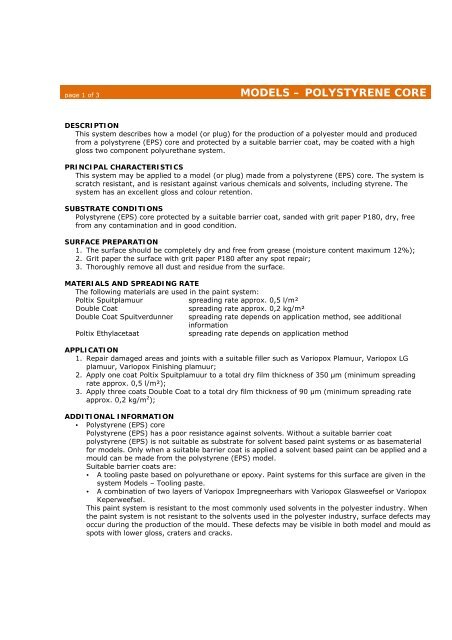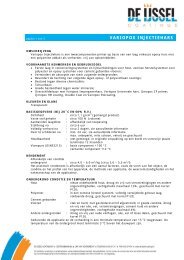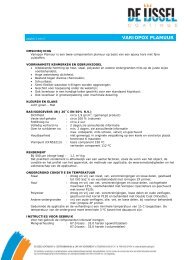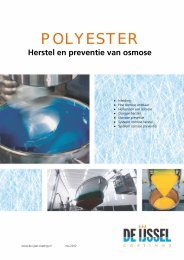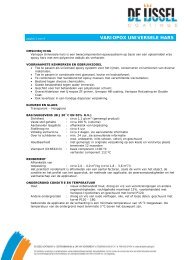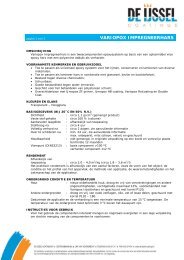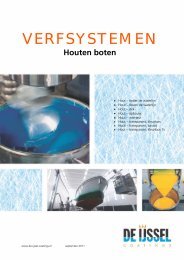MODELS – POLYSTYRENE CORE - De IJssel Coatings
MODELS – POLYSTYRENE CORE - De IJssel Coatings
MODELS – POLYSTYRENE CORE - De IJssel Coatings
Create successful ePaper yourself
Turn your PDF publications into a flip-book with our unique Google optimized e-Paper software.
page 1 of 3<br />
<strong>MODELS</strong> <strong>–</strong> <strong>POLYSTYRENE</strong> <strong>CORE</strong><br />
DESCRIPTION<br />
This system describes how a model (or plug) for the production of a polyester mould and produced<br />
from a polystyrene (EPS) core and protected by a suitable barrier coat, may be coated with a high<br />
gloss two component polyurethane system.<br />
PRINCIPAL CHARACTERISTICS<br />
This system may be applied to a model (or plug) made from a polystyrene (EPS) core. The system is<br />
scratch resistant, and is resistant against various chemicals and solvents, including styrene. The<br />
system has an excellent gloss and colour retention.<br />
SUBSTRATE CONDITIONS<br />
Polystyrene (EPS) core protected by a suitable barrier coat, sanded with grit paper P180, dry, free<br />
from any contamination and in good condition.<br />
SURFACE PREPARATION<br />
1. The surface should be completely dry and free from grease (moisture content maximum 12%);<br />
2. Grit paper the surface with grit paper P180 after any spot repair;<br />
3. Thoroughly remove all dust and residue from the surface.<br />
MATERIALS AND SPREADING RATE<br />
The following materials are used in the paint system:<br />
Poltix Spuitplamuur spreading rate approx. 0,5 l/m²<br />
Double Coat spreading rate approx. 0,2 kg/m²<br />
Double Coat Spuitverdunner spreading rate depends on application method, see additional<br />
information<br />
Poltix Ethylacetaat spreading rate depends on application method<br />
APPLICATION<br />
1. Repair damaged areas and joints with a suitable filler such as Variopox Plamuur, Variopox LG<br />
plamuur, Variopox Finishing plamuur;<br />
2. Apply one coat Poltix Spuitplamuur to a total dry film thickness of 350 μm (minimum spreading<br />
rate approx. 0,5 l/m²);<br />
3. Apply three coats Double Coat to a total dry film thickness of 90 µm (minimum spreading rate<br />
approx. 0,2 kg/m 2 );<br />
ADDITIONAL INFORMATION<br />
Polystyrene (EPS) core<br />
Polystyrene (EPS) has a poor resistance against solvents. Without a suitable barrier coat<br />
polystyrene (EPS) is not suitable as substrate for solvent based paint systems or as basematerial<br />
for models. Only when a suitable barrier coat is applied a solvent based paint can be applied and a<br />
mould can be made from the polystyrene (EPS) model.<br />
Suitable barrier coats are:<br />
A tooling paste based on polyurethane or epoxy. Paint systems for this surface are given in the<br />
system Models <strong>–</strong> Tooling paste.<br />
A combination of two layers of Variopox Impregneerhars with Variopox Glasweefsel or Variopox<br />
Keperweefsel.<br />
This paint system is resistant to the most commonly used solvents in the polyester industry. When<br />
the paint system is not resistant to the solvents used in the polyester industry, surface defects may<br />
occur during the production of the mould. These defects may be visible in both model and mould as<br />
spots with lower gloss, craters and cracks.
page 2 of 3<br />
<strong>MODELS</strong> <strong>–</strong> <strong>POLYSTYRENE</strong> <strong>CORE</strong><br />
Durability and surface preparation<br />
The durability of any paint system depends on a number of variables, amongst others: total dry<br />
film thickness, method of application, skill of labour, the conditions during which the coating is<br />
applied and cured, the exposure conditions during service and the preparation of the surface.<br />
Insufficient surface preparation might lead to blistering and loss of adhesion.<br />
Sanding<br />
A durable adhesion will be obtained by thorough preparation of the surface. This may be achieved<br />
by sanding the surface. Sanding is also necessary when the time between application of each coat<br />
exceeds the maximum overcoating interval.<br />
During application of the finishing coats, we recommend to use for each coat a finer grit paper.<br />
Application of Double Coat<br />
Double Coat may be replaced with Double Coat Modellak. Double Coat Modellak is fully cured after<br />
24 hours and is recommended when the model is exposed to the gelcoat the following day. Double<br />
Coat Modellak is fast curing and recommended for spray application to smaller models.<br />
For spray Application Double Coat Spuitverdunner may be replaced by Double Coat Spuitverdunner<br />
60. <strong>De</strong>pending on the model, Double Coat Spuitverdunner 60 will result in less overspray and<br />
better levelling.<br />
Production of the mould<br />
The model (plug) should be allowed to cure at least 5 days after application of the final coat of<br />
Double Coat. Apply several layers of release agent; a suitable release agent is Mirrorglaze TR88 or<br />
equivalent. Buff the release agent thoroughly.<br />
Forced curing<br />
Avoid forced curing of the paint system as much as possible. Forced curing might result in surface<br />
defects in the tooling paste. This will affect the surface quality of the mould negatively.<br />
Example working schedule<br />
Dry film Spreading<br />
thickness rate<br />
Step Activity<br />
(µm) (m 2 Recoating<br />
interval at<br />
/l) 20 o C Preparation before next step<br />
1 Surface pre-treatment<br />
2 Repair with Variopox Plamuur,<br />
Variopox LG plamuur or<br />
Variopox Finishing plamuur<br />
n.a. n.a 8 hours Sanding with P180.<br />
3 Apply Poltix Spuitplamuur 350 2,0 8 hours Sanding with P180-P240-P320.<br />
4 Apply first coat Double Coat 30 14,3 24 hours When recoated within 48 hours no<br />
30 14,3 24 hours<br />
5 Apply second coat Double<br />
Coat<br />
preparation required, otherwise<br />
sanding with P320-P400. Use<br />
between ach layer finer grit paper to<br />
6 Apply third coat Double Coat 30 14,3<br />
avoid scratches.<br />
24 hours After 5 days production of mould<br />
may start. Apply several layers<br />
mould release agent first.
page 3 of 3<br />
<strong>MODELS</strong> <strong>–</strong> <strong>POLYSTYRENE</strong> <strong>CORE</strong><br />
For detailed information on the products mentioned in this sheet, please refer to our technical<br />
information sheets.<br />
Date: January 12<br />
Disclaimer<br />
The information in this data sheet is based on thorough research and development in combination with practical<br />
experience, is to the best of our knowledge and correct at the date of printing. <strong>De</strong> <strong>IJssel</strong> <strong>Coatings</strong> BV does not<br />
accept any liability as the final result depends on a number of factors beyond our control, amongst others, but not<br />
limited to, skill of labour, application conditions and surface preparation. <strong>De</strong> <strong>IJssel</strong> <strong>Coatings</strong> BV reserves the right to<br />
change data without prior notice. This data sheet supersedes all previous issues.


